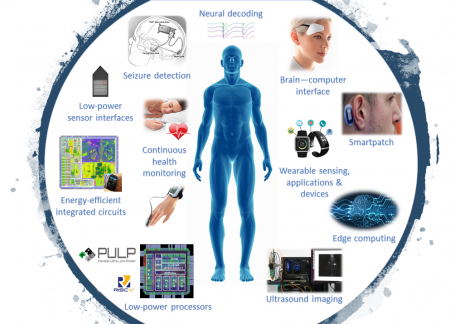|
|
| Line 1: |
Line 1: |
| − | =Biomedical Engineering=
| |
| | [[File:iis-project-image.png|thumb|right|450px]] | | [[File:iis-project-image.png|thumb|right|450px]] |
| − | The world around us is getting a lot smarter quickly: virtually every single component of our daily living environment is being equipped with sensors, actuators, processing, and connection into a network that will soon count billions of nodes and trillions of sensors. These devices only interact with the human through the traditional input and output channels. Hence, they only indirectly communicate with our brain—through our five sense modalities—forming two separate computing systems: biological versus physical. It could be made a lot more effective if a direct high bandwidth link existed between the two systems, allowing them to truly collaborate with each other and to offer opportunities for enhanced functionality that would otherwise be hard to accomplish. The emergence of miniaturized sense, compute and actuate devices as well as interfaces that are form-fitted to the human body opens the door for a symbiotic convergence between biological function and physical computing.
| |
| − |
| |
| − | Human Intranet is an open, scalable platform that seamlessly integrates an ever-increasing number of sensor, actuation, computation, storage, communication and energy nodes located on, in, or around the human body acting in symbiosis with the functions provided by the body itself. Human Intranet presents a system vision in which, for example, disease would be treated by chronically measuring biosignals deep in the body, or by providing targeted, therapeutic interventions that respond on demand and in situ. To gain a holistic view of a person’s health, these sensors and actuators must communicate and collaborate with each other. Most of such systems prototyped or envisioned today serve to address deficiencies in the human sensory or motor control systems due to birth defects, illnesses, or accidents (e.g., invasive brain-machine interfaces, cochlear implants, artificial retinas, etc.). While all these systems target defects, one can easily imagine that this could lead to many types of enhancement and/or enable direct interaction with the environment: to make us humans smarter!
| |
| − |
| |
| − | Here, in our projects, we mainly focus on '''sensor, computation, communication, and emerging storage''' aspects to develop very efficient closed-loop sense-interpret-actuate systems, enabling distributed autonomous behavior.
| |
| − |
| |
| − | <!--For example, to design the ''brain'' of our physical computing (i.e., the compute/interpret component), we rely on computing with ultra-wide words (e.g., 10,000 bits) that eases interfacing with various sensor modalities and actuators. This novel computing paradigm is called hyperdimensional (HD) computing that is inspired from the very size of the biological brain’s circuits: assuming 1 bit per synapse, the brain is made up of more than 24 billion of such ultra-wide words. You can watch some of our demos:
| |
| − | * [https://bwrc.eecs.berkeley.edu/sites/default/files/files/u2630/flexemg_v2_lq.mp4#t=2 Video1]
| |
| − | * [https://www.youtube.com/watch?time_continue=9&v=vTQGMQ6QaJE Video2]
| |
| − | * [https://iis-people.ee.ethz.ch/~arahimi/papers/ISSCC18-Demo.pdf PDF]
| |
| − |
| |
| − | You can also find a collection of complemented projects with source codes/datasets here:
| |
| − | * [https://github.com/HyperdimensionalComputing/collection Github link]
| |
| − | -->
| |
| − | ==Prerequisites and Focus==
| |
| − | If you are an B.S. or M.S. student at the ETHZ, typically there is no prerequisite. You can come and talk to us and we adapt the projects based on your skills. The scope and focus of projects are wide. You can choose to work on:
| |
| − |
| |
| − | <!-- * '''Efficient hardware architectures in emerging technologies''' (e.g., [https://www.zurich.ibm.com/sto/memory/ the IBM computational memory])-->
| |
| − | * '''Exploring new Human Intranet/IoT applications'''
| |
| − | * '''Algorithm design and optimizations''' (Python)
| |
| − | * '''System-level design and testing''' (Altium, C-programming)
| |
| − | * '''Sensory interfaces''' (analog and digital)
| |
| − |
| |
| − |
| |
| − | <!--
| |
| − | * '''Theory''' of learning systems including HD computing, Hidden Markov Model (HMM), and clustering algorithms
| |
| − | Overall, our projects cover '''algorithmic, hardware/software, and system level''' design and developments.
| |
| − | However, if you have background in signal processing, VLSI or linear algebra is a super plus! -->
| |
| − |
| |
| − | ===Useful Reading===
| |
| − | *[https://ieeexplore.ieee.org/document/7030200/ The Human Intranet--Where Swarms and Humans Meet]
| |
| − | *[https://link.springer.com/article/10.1007/s12559-009-9009-8 Hyperdimensional Computing: An Introduction to Computing in Distributed Representation with High-Dimensional Random Vectors]
| |
| − | *[https://ieeexplore.ieee.org/document/8422472/ Hyperdimensional Modulation for Robust Low-Power Communications]
| |
| − | *[https://iis-people.ee.ethz.ch/~arahimi/papers/TCAS17.pdf High-dimensional Computing as a Nanoscalable Paradigm]
| |
| − | *[http://www.oxfordscholarship.com/view/10.1093/acprof:oso/9780199794546.001.0001/acprof-9780199794546 How to Build a Brain]
| |
| − | *[https://mitpress.mit.edu/books/sparse-distributed-memory Pentti Kanerva. 1988. Sparse Distributed Memory. MIT Press, Cambridge, MA, USA]
| |
